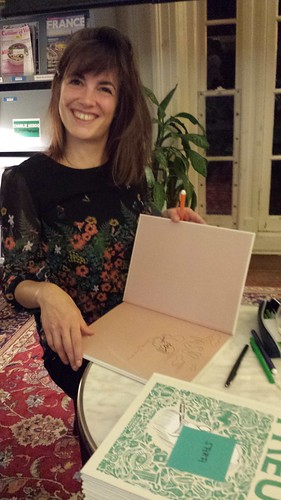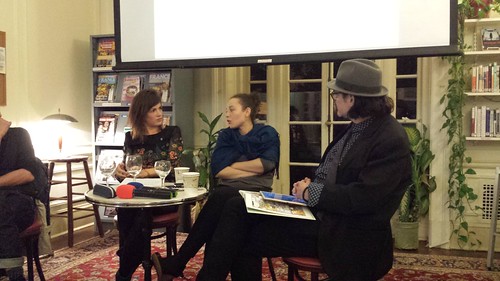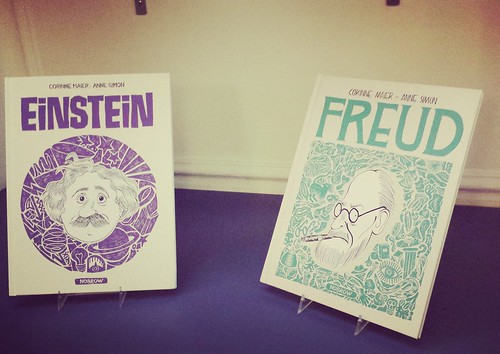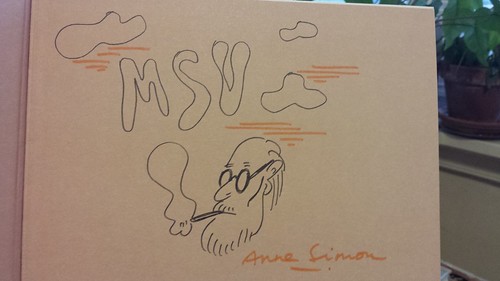 |
| Alex Alice at Takoma Public Library, photo by Bruce Guthrie |
by Mike Rhode
I was walking around at SPX when ace photographer Bruce Guthrie introduced me to a French cartoonist he had met previously at the Takoma Park Library. I wasn’t familiar with Alex Alice’s work, but I was quickly impressed by his new book and asked if we could do an interview.
Amazon
says, “Alex Alice is a French graphic
novelist, working in France and sometimes the U.S. His works have been
translated into more than fifteen languages. Born in 1974, he grew up in the
south of France and had the chance to travel around Europe, where he developed
a lifelong passion for the ruins and castles of the medieval and romantic ages.
This experience influenced his art, from the grim setting of his esoteric
thriller The Third Testament (co-written with Xavier Dorison and published by
Titan Comics) to the primeval, mythic world found in Siegfried, an operatic
re-telling of the northern saga of the great dragon slayer (published by Boom
Entertainment). In Castle in the Stars, he draws on Jules Verne and
nineteenth-century romanticism to create a watercolor world of adventure and
wonder to enchant adults and younger readers alike.
 Alice’s
new series is described as “In search
of the mysterious element known as aether, Claire Dulac flew her hot air
balloon toward the edge of our stratosphere—and never returned. Her husband,
genius engineer Archibald Dulac, is certain that she is forever lost. Her son,
Seraphin, still holds out hope. One year after her disappearance, Seraphin and
his father are delivered a tantalizing clue: a letter from an unknown sender
who claims to have Claire’s lost logbook. The letter summons them to a Bavarian
castle, where an ambitious young king dreams of flying the skies in a ship
powered by aether. But within the castle walls, danger lurks—there are those
who would stop at nothing to conquer the stars.”
Alice’s
new series is described as “In search
of the mysterious element known as aether, Claire Dulac flew her hot air
balloon toward the edge of our stratosphere—and never returned. Her husband,
genius engineer Archibald Dulac, is certain that she is forever lost. Her son,
Seraphin, still holds out hope. One year after her disappearance, Seraphin and
his father are delivered a tantalizing clue: a letter from an unknown sender
who claims to have Claire’s lost logbook. The letter summons them to a Bavarian
castle, where an ambitious young king dreams of flying the skies in a ship
powered by aether. But within the castle walls, danger lurks—there are those
who would stop at nothing to conquer the stars.”
Mike
Rhode: [After two other series, now] you are the author of Castle in the Stars:
The Space Race of 1869. How many books are there in the series? Four?
Alex Alice: Probably
more than that. This first story concludes in book 2. The universe of the story
is so interesting to me that I keep having new ideas. The idea is that there is
space travel in the nineteenth century, so I ask, ‘What if we had come up with a
way to travel through space in 1869 instead of 1969?” and this opens up a whole
world of adventure and possibilities. Space isn’t the way we know it today; it’s
the way scientists imagined it at the time.
MR:
Are you more influenced by 19th century authors such as Jules Verne
or by 21st century steam punk? Or both?
 AA:
I would say I’m a fundamentalist steam punk writer so I go back to the roots.
It’s Jules Verne and actual scientific hypotheses of this particular time
period. It’s hard core steam punk, or hard steam punk, or… I’m trying to be as
science-based as I can, perfectly realizing that this is a fantasy. I’m trying
to be as close as I can to what people of the 19th century would have
found believable.
AA:
I would say I’m a fundamentalist steam punk writer so I go back to the roots.
It’s Jules Verne and actual scientific hypotheses of this particular time
period. It’s hard core steam punk, or hard steam punk, or… I’m trying to be as
science-based as I can, perfectly realizing that this is a fantasy. I’m trying
to be as close as I can to what people of the 19th century would have
found believable.
MR:
It’s Newtonian physics, instead of Einsteinian physics, and you can propel
yourself through the space because there’s something to push against?
AA:
Yes, and use as fuel.
MR:
How many books in the series are out already?
AA:
Book three just came out. My publisher in France is a fairly new publishing
house Rue de Sèvres,
which is an imprint of L'École des loisirs. They are a very respectable
children’s book publisher that started a graphic novel imprint. This is very exciting
for me because this is not a book for kids, it is a book that is also for kids, and I’m very glad to
work with this publisher who has an ability to reach a younger audience.
MR:
The same is true for your American publisher First Second…
AA:
Is it? I was hopeful for that, because that’s what they told me [laughing].
MR:
Let’s talk about technique… you occasionally build models for some of the
spaceships?
AA:
Yes, again, in the idea to have something as believable as I can. I was fascinated
by this idea setting the story in a world where it’s not just alternate
history, it’s an alternate cosmos. It’s not consistent with what we know about
space and science now. My challenge was to say, “This is not believable for
modern audiences so how am I going to pull the reader into my story?” My idea
was that I didn’t care if it wasn’t true, [rather] it was something people
could have believed at some point.
The important thing for me is as I’m writing it, I believe it. I am not a scientist, and I’m perfectly aware that aether doesn’t exist. I believe in my story as I’m writing it, and it’s easy for me; to be perfectly honest, the vision of Venus that people had at the time … we could see from the telescope that it was covered in clouds, which is true; we could see it was closer to the sun so it must have been very hot ,which is true; so they thought, it’s hot, it’s cloudy, there must be a lot of water so there must be huge jungles down there. Because they thought that planets had appeared in the order of their distance from the sun, they thought Venus was younger than earth so life must not have reached the same development and be stuck in an earlier era. So they genuinely thought Venus was a jungle world filled with dinosaurs, and this sounds like a pulpy sci-fi world of Edgar Rice Burroughs, but it is the actual science hypothesis of the time. This is fascinating to me, and very poetic. I find this hypothesis easier to envision, and too imagine, and frankly easier to believe in than the actual reality of Venus which is a hell world with incredible pressure and acid rains [laughs].
I found it was quite easy to believe in this world as I was writing it. To help me believe in it, I had a model made of the main machine that will allow the characters to travel to the stars. I even had an aether suits made life-sized of leather and wood. I had to talk with model makers and costume makers, and having their input of how they would do it and what would work. This world is 100% believable for me and I’m comfortable writing this story.
The important thing for me is as I’m writing it, I believe it. I am not a scientist, and I’m perfectly aware that aether doesn’t exist. I believe in my story as I’m writing it, and it’s easy for me; to be perfectly honest, the vision of Venus that people had at the time … we could see from the telescope that it was covered in clouds, which is true; we could see it was closer to the sun so it must have been very hot ,which is true; so they thought, it’s hot, it’s cloudy, there must be a lot of water so there must be huge jungles down there. Because they thought that planets had appeared in the order of their distance from the sun, they thought Venus was younger than earth so life must not have reached the same development and be stuck in an earlier era. So they genuinely thought Venus was a jungle world filled with dinosaurs, and this sounds like a pulpy sci-fi world of Edgar Rice Burroughs, but it is the actual science hypothesis of the time. This is fascinating to me, and very poetic. I find this hypothesis easier to envision, and too imagine, and frankly easier to believe in than the actual reality of Venus which is a hell world with incredible pressure and acid rains [laughs].
I found it was quite easy to believe in this world as I was writing it. To help me believe in it, I had a model made of the main machine that will allow the characters to travel to the stars. I even had an aether suits made life-sized of leather and wood. I had to talk with model makers and costume makers, and having their input of how they would do it and what would work. This world is 100% believable for me and I’m comfortable writing this story.
MR:
How has the reception been for it in France?
AA:
I was very happy with it. I was hoping to make a book that would appeal to
adults and children alike, in the tradition of Tintin, that was marketed as for
‘children between 7 and 77.’ That was a catchline
for Tintin in France. That was my goal and I was very happy to see families to
come signings, and say, “This is the only bandes dessinee that I read, that my
children read as well.” And vice-versa.
MR:
So what brings you to the Washington area?
AA:
My American publisher, First Second, thought it would be great for me to come
to SPX which I’ve never been to before. I’m much more comfortable here than I
was when I visited Comic-Con in New York a number of years ago. First of all, I’m
not a huge superhero fan, and secondly, it was strange for me to talk to
artists who work on someone else’s character which is not at all in the French
tradition. Whereas here, I feel like everyone is doing their own story, and I find
much more common ground, even if their stories or their visual styles are completely
different from mine. I feel I have maybe something in common with a lot of the
artists here.
MR:
So how do you do your art? Is it drawn in pencil, and then inked, and then
water-colored? Or digitally colored?
AA:
It’s all done in the real world. I try to do everything on the same page – the pencilling,
the letters, the color… because I really like to have the original artwork in
front of me, looking as it will in the final page.
MR:
Ah, a classicist.
AA:
Yes, part of it is the pleasure of having the actual page in front of me; part
of it is laziness [laughs] because I like to be able to judge the exact amount
of details I will have to put in.
MR:
That makes perfect sense to me. There’s a political cartoonist here at SPX
named Matt Wuerker who still watercolors his cartoons every day by hand because
it’s faster. And he knows what he’s getting.
AA:
And it’s faster. People don’t
realize that. The computer will not
save you time. For most things…
MR:
So it was watercolors that you use, and not colored pencil?
AA:
It is actually at little watercolor and a lot of calligraphy’s colored inks
that are permanent.
AA:
Yes.
MR:
Did you pitch the book to your publisher, and then get an advance to do it?
AA:
Yes.
MR:
Because traditionally in France in the golden days, and I think this is mostly
gone now, but Tintin would be one page per week in the newspaper, and then be
collected in an album.
AA:
Right, and the artist would have a salary. The salary is entirely gone, but we
do get an advance in France, when you sign with a major publisher.
MR:
You have the complete original art at the end of a book. Do you sell it? Is
that another revenue stream for you?
AA:
Potentially yes. [laughs] But I haven’t sold pages in a while especially
because I wanted to set up an exhibition, which we did at Angouleme which is
the biggest festival in the south of France. This year at Angouleme we had the
means to do a big show, with even more props and models and sounds and a moon
and a lot of costumes of the time period… we made the world pop out of the
page. I wanted to keep my art for that. I will be doing a commercial show in
New York next year.
MR:
You mentioned ‘the world’… I just bought your book and I haven’t read it yet.
Is this book about going to Venus?
 AA:
In book one, Seraphin is talking about Venus in the beginning, but the story is
actually him and his father trying to follow the footsteps of his mother who
disappears in the first scene in a balloon flight. Her logbook is found by
someone who sends a letter to Seraphin and his father and gives them a rendezvous
in Bavaria. We don’t know who this character is, or what he wants, but when
they get there, we find out that it is the King of Bavaria, King
Ludwig II, and he is planning on space exploration.
AA:
In book one, Seraphin is talking about Venus in the beginning, but the story is
actually him and his father trying to follow the footsteps of his mother who
disappears in the first scene in a balloon flight. Her logbook is found by
someone who sends a letter to Seraphin and his father and gives them a rendezvous
in Bavaria. We don’t know who this character is, or what he wants, but when
they get there, we find out that it is the King of Bavaria, King
Ludwig II, and he is planning on space exploration.
MR:
Is he still building a big castle?
AA:
Actually, it is only the historical approximation that I made consciously. I
might have made several mistakes, but he has already built his Neuschwanstein
castle at this point, because I really wanted to draw this castle and I
wanted to set the story just before the Franco-Prussian War of
1870.
MR:
So you are using real historical characters and following real historical events?
AA:
I am. I made a point of having the story begin the real world as much as I
could.
MR:
Where are you finding your background information from? In America we had
Popular Science, and Popular Mechanix and even Scientific American. Are you
using the French equivalent of those?
AA:
Yes, I guess. I’m especially using Camille Flammarion
who wrote a popular astronomy in the latter half of the 18th
century. It was very popular at the time, and these sort of popular science
texts were quite an influence.
MR:
In America they have a lot of magazine covers of the giant airplanes, and the
future was going to be great…
AA:
Or terrifying, depending on the cover.
MR:
Looking at the cover of your book, are you influenced by Miyazaki?
 AA:
The answer is definitely yes, but my
primary influences are the reading of Jules Verne and the travels I did through
Europe as a kid. There’s a lot of things here that I’m using that Miyazaki was also
using. That being said, I adore Miyazaki’s work, and his influence with this
type of story is impossible to escape so I embraced it. The title of the book,
and one of my characters, are influenced by a Miyazaki character from Future Boy Conan. There’s
also a wonderful film that’s maybe lesser-known called The Castle of
Cagliostro. It’s a masterpiece. It’s one of the best adventure films ever made.
It’s incredibly fun, and touching, and full of wonder... one of the greatest.
One of the scenes from Castle in the Stars that I was really happy with, where
I had a wonderful idea and did the scene and did the book, and the book was
printed, and I showed Castle of Cagliostro to my son and realized I had stolen
the whole scene! [laughs] As it happens.
AA:
The answer is definitely yes, but my
primary influences are the reading of Jules Verne and the travels I did through
Europe as a kid. There’s a lot of things here that I’m using that Miyazaki was also
using. That being said, I adore Miyazaki’s work, and his influence with this
type of story is impossible to escape so I embraced it. The title of the book,
and one of my characters, are influenced by a Miyazaki character from Future Boy Conan. There’s
also a wonderful film that’s maybe lesser-known called The Castle of
Cagliostro. It’s a masterpiece. It’s one of the best adventure films ever made.
It’s incredibly fun, and touching, and full of wonder... one of the greatest.
One of the scenes from Castle in the Stars that I was really happy with, where
I had a wonderful idea and did the scene and did the book, and the book was
printed, and I showed Castle of Cagliostro to my son and realized I had stolen
the whole scene! [laughs] As it happens.
MR:
Are you going anywhere else in the States?
AA:
Yes, it’s a short but intense tour with the Brooklyn Book Festival tomorrow and
then the Boston area for libraries and schools.







